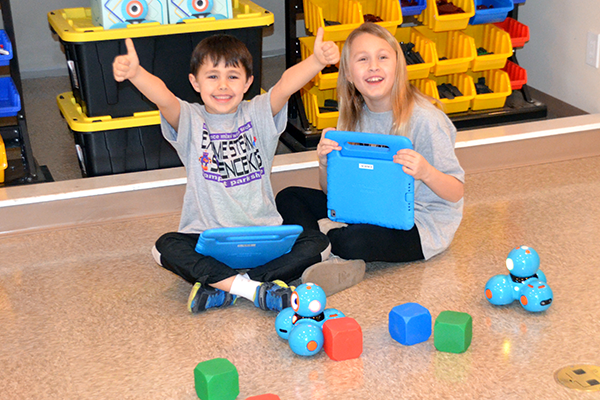By Stacey Susinno, Mom, 8th grade Regents Earth Science Teacher and Director of Extreme STEAM Science Kids at Park Shore Country Day Camp
I have gamers. If you are unfamiliar with this somewhat new breed of child: this is a creature who, if allowed, will sit for hours on end hooting and hollering at a screen (sometimes even needing to be reminded to eat or use the bathroom). Why do video games have such an enthralling appeal? Children learn through consequence on video games. Take Minecraft for example. I have played in what my kids laughingly call non-survival mode. I was so terrible a player that I had to have them join my game to protect me. I needed digital body guards! Once I was able to evade spiders and creepers for a long enough time (I couldn’t shake the pig following me), I couldn’t figure out how to stop drowning. Sound macabre? We guffawed every time little Steve sunk to the bottom of a blocky ocean and his life-line ran out. Video games are rewarding. Children learn through repeated failure AND ENJOY IT!
Now cut to the classroom. I have had to console many 8th graders for scoring less than a desired grade on a unit test because they “felt prepared” and “thought they did better”. I’ve seen many students shut down, write themselves off as non-learners and/or keep the same study preparations that didn’t work the first time. Many kids have somehow adopted this idea in the classroom that they should be experts immediately and without practice. They feel dejected when they aren’t. Gamers don’t even think of losing a videogame as failure. In gaming, failure forces you to reflect, re-evaluate, and change your method to one that leads to success through repeated practice. What if we can encourage a gamer’s’ view of failure in the classroom? Enter: Game-based learning.
A teacher might spend several periods of science class teaching the pH of certain substances. I’ve delivered this lecture in 8th grade Earth Science as a precursor to chemical weathering. After about the 2nd minute, students’ eyes glaze over and I’ve lost them. Recently, I was assigned to cover the class of a colleague whom I’ve shared game-based learning ideas with before. I knew I was in for a treat. The 6th grade students were playing a game on Chromebooks to learn the very same pH ideas I’ve lectured my own classes on. In this online (free) game students are presented with challenges and have to test different virtual substances to see if they can make an alien survive. The first challenge is the setup of the juice bar for the aliens in which students create acids and bases virtually, through trial and error. What happens when they get something wrong? The Alien gets sick. A few students muttered condolences for the Virtual Alien and all were determined to save his life. All students came out of the laboratory activity with a working knowledge of acids and bases. At the end of the class, I asked a few questions to see if they really understood the concepts. Students were able to identify the pH of an acid, base and a neutral substance. They were able to give examples of each, and they were even able to predict what would happen to pH when they mixed substances. Through trial and error and a lot of laughs, students actually retained more application skill through the video game and now have the conceptual foundation they will need for later science classes.
I know what you’re thinking. Not every lesson in life, home or school can be a game. You’re right. No teacher in their right mind would make every lesson a game in the same way a parent wouldn’t allow their child to sit in front of Minecraft all day because it has some learning benefits. Game-based learning is just another tool in our arsenal to reach every learner in a style that engages them on an individual level. According to Pearson, game-based learning provides more engagement for the learner, personalizes learning opportunities and levels, teaches 21st century technology skills, and provides a low-risk environment for authentic and relevant assessment. As a teacher I see that game-based learning also helps students retain concepts longer, provides opportunity for strategic thinking and problem solving and most importantly, may engage the hardest to reach students. Games are generally designed to move from one task to the next in quick succession, so students with shorter attention spans thrive with this instructional method. Game pace is determined by the player, so processing time is given as needed. For some students, communicating through an avatar may be more comfortable and allows them to interact socially with more frequency. I know that all of my students’ faces light up when they see the Chromebooks set up in the classroom. To them it’s fun. To me it’s valuable learning on many levels. Let the games begin!


Recent Comments